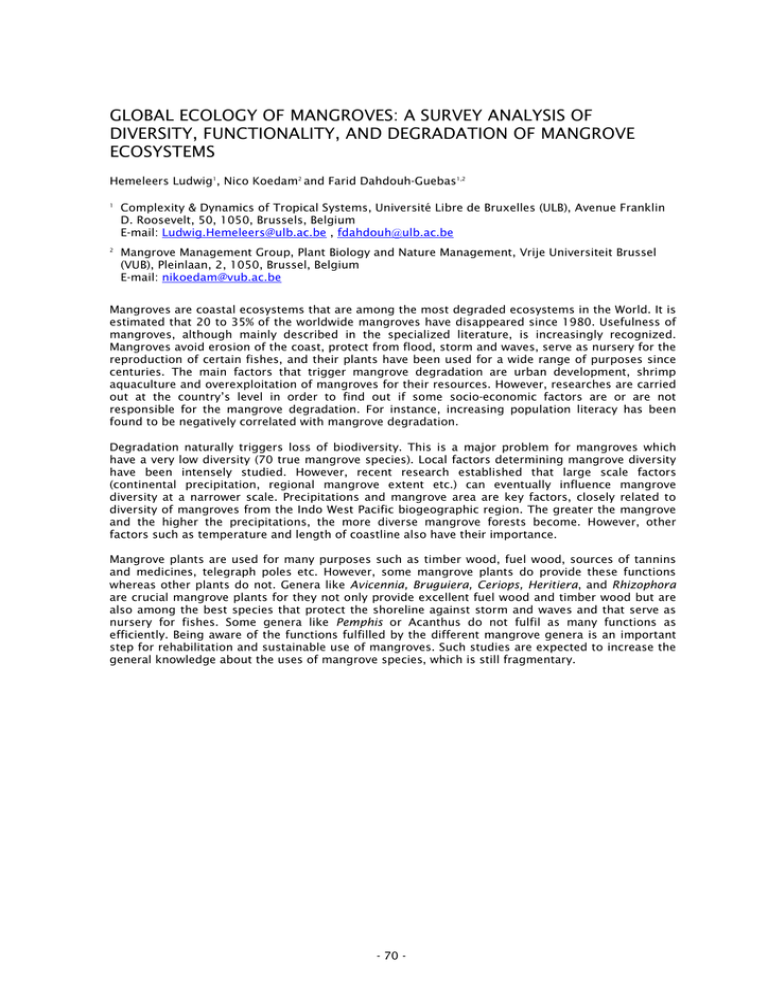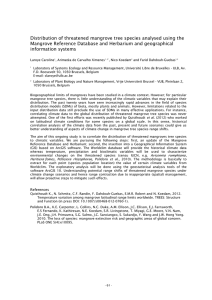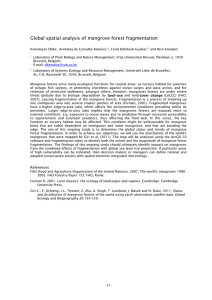GLOBAL ECOLOGY OF MANGROVES: A SURVEY ANALYSIS OF
advertisement

GLOBAL ECOLOGY OF MANGROVES: A SURVEY ANALYSIS OF DIVERSITY, FUNCTIONALITY, AND DEGRADATION OF MANGROVE ECOSYSTEMS Hemeleers Ludwig1, Nico Koedam2 and Farid Dahdouh-Guebas1,2 1 Complexity & Dynamics of Tropical Systems, Université Libre de Bruxelles (ULB), Avenue Franklin D. Roosevelt, 50, 1050, Brussels, Belgium E-mail: Ludwig.Hemeleers@ulb.ac.be , fdahdouh@ulb.ac.be 2 Mangrove Management Group, Plant Biology and Nature Management, Vrije Universiteit Brussel (VUB), Pleinlaan, 2, 1050, Brussel, Belgium E-mail: nikoedam@vub.ac.be Mangroves are coastal ecosystems that are among the most degraded ecosystems in the World. It is estimated that 20 to 35% of the worldwide mangroves have disappeared since 1980. Usefulness of mangroves, although mainly described in the specialized literature, is increasingly recognized. Mangroves avoid erosion of the coast, protect from flood, storm and waves, serve as nursery for the reproduction of certain fishes, and their plants have been used for a wide range of purposes since centuries. The main factors that trigger mangrove degradation are urban development, shrimp aquaculture and overexploitation of mangroves for their resources. However, researches are carried out at the country’s level in order to find out if some socio-economic factors are or are not responsible for the mangrove degradation. For instance, increasing population literacy has been found to be negatively correlated with mangrove degradation. Degradation naturally triggers loss of biodiversity. This is a major problem for mangroves which have a very low diversity (70 true mangrove species). Local factors determining mangrove diversity have been intensely studied. However, recent research established that large scale factors (continental precipitation, regional mangrove extent etc.) can eventually influence mangrove diversity at a narrower scale. Precipitations and mangrove area are key factors, closely related to diversity of mangroves from the Indo West Pacific biogeographic region. The greater the mangrove and the higher the precipitations, the more diverse mangrove forests become. However, other factors such as temperature and length of coastline also have their importance. Mangrove plants are used for many purposes such as timber wood, fuel wood, sources of tannins and medicines, telegraph poles etc. However, some mangrove plants do provide these functions whereas other plants do not. Genera like Avicennia, Bruguiera, Ceriops, Heritiera, and Rhizophora are crucial mangrove plants for they not only provide excellent fuel wood and timber wood but are also among the best species that protect the shoreline against storm and waves and that serve as nursery for fishes. Some genera like Pemphis or Acanthus do not fulfil as many functions as efficiently. Being aware of the functions fulfilled by the different mangrove genera is an important step for rehabilitation and sustainable use of mangroves. Such studies are expected to increase the general knowledge about the uses of mangrove species, which is still fragmentary. - 70 -






